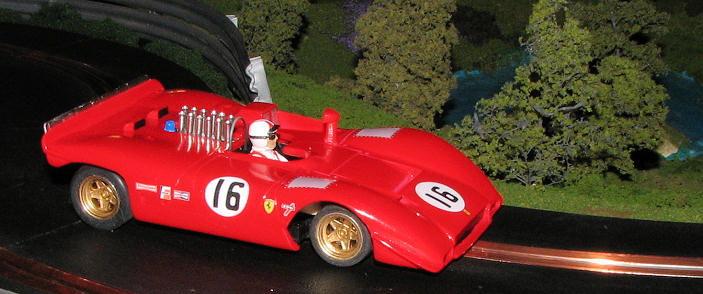
| KIT #: | ? |
| PRICE: | $45.00 for the body |
| DECALS: | None included |
| REVIEWER: | Scott Van Aken |
| NOTES: | Resin with metal injector stacks |

| HISTORY |
For the 1969 battle in the Can Am, Ferrari fielded their 612P which was debuted at the final race of 1968 at Las Vegas and failed to finish the race. However, this time the Ferrari effort was headed by Kiwi driver Chris Amon with Maranello playing a support role. The first appearance would be at the Watkins Glen Can Am race held in mid-July. Gone were the complex hydraulically-actuated high wing and nose-mounted speed brake. This, along with all new body work, allowed the car to shed some weight. The chassis and engine were the same as the 1968 Las Vegas race, but the weight loss enabled Chris Amon to qualify 3rd, just behind the McLaren M8Bs of Bruce McLaren and Denny Hulme. With such a high qualifying position, it looked to be a promising race for what would become known as the second-generation 612P. Amon remained competitive throughout the race remaining within striking distance of the two bright orange McLarens. The final result would be a 3rd place finish for the Ferrari; but more importantly, a shot in the arm to the Can Am Series which was beginning to suffer from Team McLaren's domination.
Chris Amon would again deliver a spectacular show with the
612P at the following race in Edmonton, Alberta, Canada. The car was fitted with
a new 6.2 litre engine for this event. This proved exciting as the engine is
claimed to be why the Ferrari's gearbox broke during practice, but nonetheless,
Amon would onc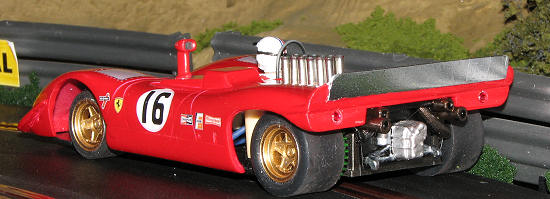 e
again occupy third position on the grid behind the brilliant McLarens of Bruce
and Denny. Shortly following the green flag, Amon was able to pass Bruce
McLaren's M8B to snatch second position. This started a battle unlike that which
the McLaren cars had ever seen. Amon and McLaren would swap second place for
several more laps until the M8B's Chevy engine gave out. This left second
position to the Ferrari, which it would retain for the remainder of the race.
e
again occupy third position on the grid behind the brilliant McLarens of Bruce
and Denny. Shortly following the green flag, Amon was able to pass Bruce
McLaren's M8B to snatch second position. This started a battle unlike that which
the McLaren cars had ever seen. Amon and McLaren would swap second place for
several more laps until the M8B's Chevy engine gave out. This left second
position to the Ferrari, which it would retain for the remainder of the race.
Amon would continue his streak of podium finishes with the big red Ferrari at Mid Ohio. Despite a poor qualifying result of 12th place, Amon managed to bring the Ferrari up through the pack to finish third, one lap behind the McLarens. Elkhart Lake was the next race, and the Ferrari 612P arrived with a major new aerodynamic wing mounted on struts above the rear of the car. Bracing was used to support the wing struts off the car's roll bar. Amon and the Ferrari would start the race from seventh position, but a faulty fuel pump would lead to an early end for the New Zealand driver and the 612P. Bridgehampton would deliver similar results for Ferrari, as Amon gridded the car in P3, his race would once again be cut short due to a broken oil pump shaft. Pedro Rodriguez would save the prancing horse's reputation at Bridgehampton with his 312P endurance racer. Pedro qualified 11th and drove the 312P to a fifth place finish, some 4 laps down from the leader. Amon would take the big Ferrari to the races at Michigan and Laguna Seca, but engine problems would result in the car not taking to the grid at these two events.
Riverside Raceway, late October 1969, would provide the
backdrop for the largest Ferrari V-12 to ever turn a wheel in anger. Still
retaining chassis number 0866, the car that originally debuted at Las Vegas a
year earlier, Chris Amon and his mechanics fitted a
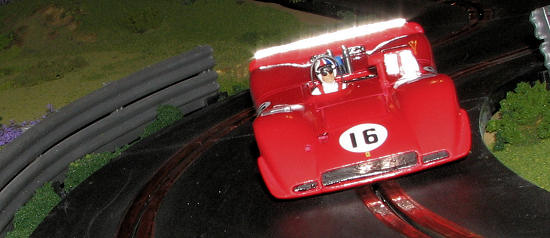 monstrous 6.9
litre V-12 engine to the big red car. Maranello was able to achieve the 6.9
litre displacement by stroking the original 6.2 litre engine. The addition of
the larger engine to the 612P led to a new designation, that of 712P, indicating
near 7.0 litres of displacement. Amon would use the extra displacement to
overcome the Ti22 of Jackie Oliver for third fastest on the grid behind both
McLarens. Ultimately the extra power would come to no advantage, as Amon retired
the Ferrari after being black flagged by officials for receiving an illegal push
start. Amon would appear one final time before departing for March in 1970. The
final race of the 1969 season was held at Texas International Speedway. Amon
used chassis number 0866 in 712P trim to qualify, blowing the 6.9 litre engine
and thus having to run the race with the spare 6.2 litre unit. The big engine
did the trick in qualifying, with Amon getting 4th on the grid. The smaller
engine wasn't to last either as it too blew early on in the race, leading to yet
another DNF. Chris Amon parted ways with Ferrari at the end of 1969, but he did
manage to score 39 points in the Can Am Championship which was enough to put him
in 6th place overall in the point standings.
monstrous 6.9
litre V-12 engine to the big red car. Maranello was able to achieve the 6.9
litre displacement by stroking the original 6.2 litre engine. The addition of
the larger engine to the 612P led to a new designation, that of 712P, indicating
near 7.0 litres of displacement. Amon would use the extra displacement to
overcome the Ti22 of Jackie Oliver for third fastest on the grid behind both
McLarens. Ultimately the extra power would come to no advantage, as Amon retired
the Ferrari after being black flagged by officials for receiving an illegal push
start. Amon would appear one final time before departing for March in 1970. The
final race of the 1969 season was held at Texas International Speedway. Amon
used chassis number 0866 in 712P trim to qualify, blowing the 6.9 litre engine
and thus having to run the race with the spare 6.2 litre unit. The big engine
did the trick in qualifying, with Amon getting 4th on the grid. The smaller
engine wasn't to last either as it too blew early on in the race, leading to yet
another DNF. Chris Amon parted ways with Ferrari at the end of 1969, but he did
manage to score 39 points in the Can Am Championship which was enough to put him
in 6th place overall in the point standings.
| THE KIT |
Well, this isn't really a standard kit. What the deal is with this as with many aftermarket slot car bodies is the company provides a body and suggests the chassis and decals. It is then up to the builder to bring together all the pieces needed to get a running slot car. If one has been at it long enough, some of these pieces will already be on hand. If not, there will be a number of places where various bits can be found.
| CONSTRUCTION |
First thing to do is to prepare the body. This one is just
like any aircraft/ship/armor resin body in that there is flash to remove, mold
lines to sand down and in this case, a few holes to fill. Two of them were for
the wing, which I decided not to use. This wing is the same as provided in their
McLaren M12 body and while fine for that, is not the same as what was used on
the Ferrari 612P. I simply filled the holes with plastic rod and used super glue
as a filler. Then the op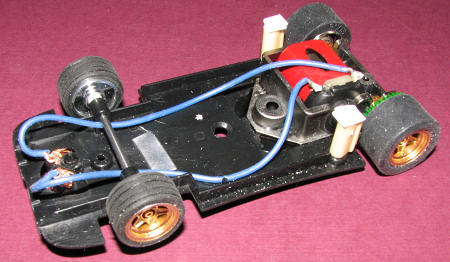 ening
was sanded down on both sides. One needs to do the underside of these cars as
clearance is sometimes an issue.
ening
was sanded down on both sides. One needs to do the underside of these cars as
clearance is sometimes an issue.
With the body prepped, it was set aside for painting.
I then gathered the parts for the chassis. There are two chassis recommened for this car. One is for the Slot.it Alfa 33 and other is for the Fly Porsche 908 Flunder. I had used the Alfa 33 Chassis for the McLaren and found it wasn't the best choice as there wasn't clearance for the proper height rear tires. I eventually spent the bucks on a replacement motor pod for that car, which helped considerably, but wanted to try the other route on this one.
Finding the Fly chassis wasn't the easiest as the company has been through bankruptcy and spares were difficult to locate. The Flunder chassis comes in two pieces; a forward section and a motor pod. I found the forward section easily enough, but the motor pod wasn't such a snap. I finally found one from a place that routinely has higher than retail prices, but it was the only choice so I ordered one.
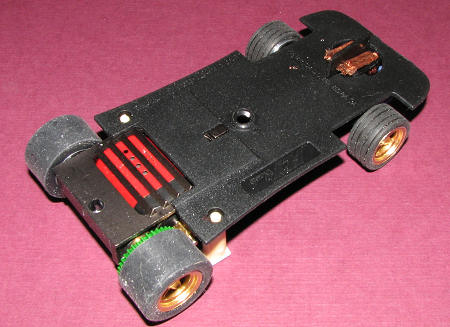 When it
arrived, I installed the motor. This came from an MRRC Cobra which I replaced
with something of lower power as it was just too much for the car. This is a red
can motor that had been sitting in the bits box for months. It was snapped into
place along with a pair of brass bearings. I then cut a couple of sections of
3/32 piano wire to use for axles. This stuff is great as you get 6 feet of it
for about $3. Enough for several dozen axles. For wheels, I used the very nice
BWA ones. These come in a variety of sizes and I've used them for years. BWA
also does a number of resin inserts and has the ones that are correct for this
car. For gears, I used an 11 tooth pinion and a 38 tooth spur gear, both from
Slot.it. I originally installed a Ninco spring loaded guide, but had to remove
it as it was too tall. In its place, I substituted a Slot.it snap in guide as
come with their RTR cars. This pretty much completed the chassis and it was run
for several laps to be sure it all worked properly. Before setting that aside, I
aligned it with the body and drilled out the screw holes so there would be no
problems mounting the chassis when the body was done.
When it
arrived, I installed the motor. This came from an MRRC Cobra which I replaced
with something of lower power as it was just too much for the car. This is a red
can motor that had been sitting in the bits box for months. It was snapped into
place along with a pair of brass bearings. I then cut a couple of sections of
3/32 piano wire to use for axles. This stuff is great as you get 6 feet of it
for about $3. Enough for several dozen axles. For wheels, I used the very nice
BWA ones. These come in a variety of sizes and I've used them for years. BWA
also does a number of resin inserts and has the ones that are correct for this
car. For gears, I used an 11 tooth pinion and a 38 tooth spur gear, both from
Slot.it. I originally installed a Ninco spring loaded guide, but had to remove
it as it was too tall. In its place, I substituted a Slot.it snap in guide as
come with their RTR cars. This pretty much completed the chassis and it was run
for several laps to be sure it all worked properly. Before setting that aside, I
aligned it with the body and drilled out the screw holes so there would be no
problems mounting the chassis when the body was done.
| COLORS & MARKINGS |
During much of this, I worked on the body. I chose Tamiya Red in a spray can and so painted the body and the rear view mirror assembly using this shade. I always have trouble with red and with spray cans so the finish isn't great, but good enough.
Meanwhile I started cleaning up and painting the interior, driver, rear body piece and the engine piece. We are talking mostly black, white and metallics for this using a variety of paints. All of this was done at a rather leisurely pace as I did slot car stuff in between other builds and work.
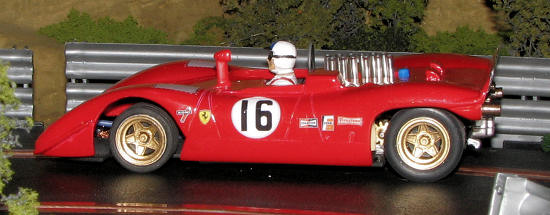 For decals, I
had bought the Slotcars4U sheet that covered the McLaren M12 as well as two
different liveries for this car. I chose the early livery with the white circle
numbers as used when it was without the wing and finished in 3rd place at the
1969 Watkins Glen Can Am. The second option is for a more flamboyant set of
numbers, more adverts and the wing. The decals went on well. These are ALPS
printed decals so are somewhat fragile and somewhat transparent. I put down some
more opaque blank white circles of the same size then put the ALPS printed ones
atop them. It seems to have cut back almost all the bleed-through of the
underlying red. For the small batch of other decals, I doubled up on all of
them, thanks to Slotcars4U providing duplicates of all the markings. I used
Microsol on these with good effect.
For decals, I
had bought the Slotcars4U sheet that covered the McLaren M12 as well as two
different liveries for this car. I chose the early livery with the white circle
numbers as used when it was without the wing and finished in 3rd place at the
1969 Watkins Glen Can Am. The second option is for a more flamboyant set of
numbers, more adverts and the wing. The decals went on well. These are ALPS
printed decals so are somewhat fragile and somewhat transparent. I put down some
more opaque blank white circles of the same size then put the ALPS printed ones
atop them. It seems to have cut back almost all the bleed-through of the
underlying red. For the small batch of other decals, I doubled up on all of
them, thanks to Slotcars4U providing duplicates of all the markings. I used
Microsol on these with good effect.
With the decals dry, did the detail painting then covered the rear spoiler with Bare Metal Foil. Then I gave the body a good coat of Testors clear gloss lacquer paint to seal everything in and add protection. The last painting needed were to paint the inside of the wheels and the inserts with gold. I used Testors Model Master for this, gluing the inserts with super glue after painting the back section of the wheels with black.
| FINAL CONSTRUCTION |
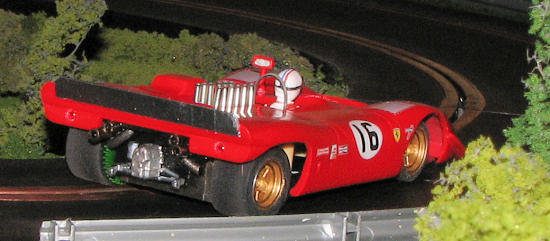 off the
top of the steering wheel to get things to fit. I guess this is all learning
process stuff. I also painted the driver's helmet to mimic that worn by the
car's driver; Chris Amon. The last thing to glue on was the rear view
mirror.
off the
top of the steering wheel to get things to fit. I guess this is all learning
process stuff. I also painted the driver's helmet to mimic that worn by the
car's driver; Chris Amon. The last thing to glue on was the rear view
mirror. | CONCLUSIONS |
When done, I took the car to the track to see how it ran. Despite the rather heavy resin body, the car is very quick. In fact, it is about as fast as the now upgraded and improved McLaren M12. It isn't the fastest I have, but then, I didn't build it to be real fast. I built it because I wanted the car. Simple as that. Were I to change anything, I'd widen the track as the tires seem a bit too far back in the wheel wells. Maybe after a while.
For a rundown on what was spend on this (and you have to realize that I frequently over-order parts in anticipation for these sorts of projects) it came to this:
Body: $45
Decals: $8
Wheels: $16 for the four
Chassis: $18
Inserts: $4 for four
Spur Gear: $8
Pinion Gear: $2
Axles: about 10 cents for two
Bearings:$4
Indy Grip rear tires: $4.50
MV Products LS 30 lenses $1.10
That brings my expenditure to $122.60 for the various parts.
I already had the motor and guide flag (actually, I had most of these parts on hand anyway), but if not, one would need to add about $20 to the total.
Yes, pricey it is in some respects, but then I have a car that few would have and I got the enjoyment of working out the problem areas and adding my own touches to the car. Worth it? Yes, to me and I guess that is really what this is all about.
| REFERENCES |
http://ezinearticles.com/?Ferrari---The-Can-Am-Experience&id=3322220
March 2010 If you would like your product reviewed fairly and quickly, please
contact
me or see other details in the
Note to
Contributors.